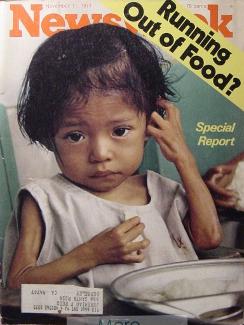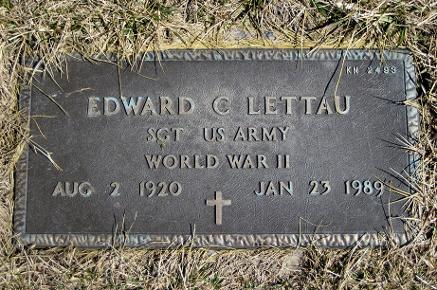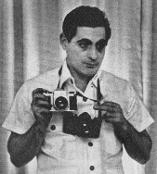
Jerry Yulsman - Jerry Yulsman was another top-notch photographer whose photographs were published in Playboy. He often did photo satires for the magazine, as well as other assignments throughout the late 1950s and the entirety of the 1960s. He also shot glamorous subjects for other magazines.
Jerome Yulsman was born on Feb. 8, 1924 in Philadelphia, Pennsylvania. He received his first camera, an Argus, from an aunt for his 12th birthday and took to his new hobby right away, feeling his skill with the camera was a "gift from Providence".
In 1941, at the age of 17, he lied about his age and enlisted in the Army Air Corps. In the Army photography school at Denver's Lowry Field, he learned to operate a "gun camera". Serving in North Africa during WWII, he was promoted to Master Sergeant, and on August 1, 1943, he flew in Operation Tidal Wave, a bombing raid on the Romanian oil refineries of Ploesti, which were a major source of oil for the Nazi war machine. This combat action brought him the Distinguished Flying Cross, which is awarded for "heroism or extraordinary achievement while participating in an aerial flight".
Following the war, Yulsman moved to Manhattan where he became a successful freelance photojournalist, shooting "jazz, politics and girls" and hanging out in Greenwich Village at the Limelight Cafe. He began shooting for magazines like Collier's in 1947 and in 1957 began his long association with Playboy.
Jerry's contributions to Playboy include:
Nov. 1957 issue - shot the first of his two Playboy covers. Inside that same issue, he also shot 3 pages of photos for the article "Playboy on Poker".
August 1958 issue - shot a 5 page photo satire called "History Revisited", in which Yulsman himself portrayed Napoleon Bonaparte (surrounded by two topless models) in the final photograph.
Feb. 1959 issue - shot a gorgeous 4 page color pictorial entitled "Girls in Their Lairs".
June 1959 issue - shot a 4 page photo satire on the scooter craze called "Veni, Vidi, Vespa!". Playboy editors commented: "You see Jerry on this page in the act of setting up one of the tricky jobs for which he's famous: photographing a nude on a busy city street in broad daylight."
Oct. 1964 issue - an 8 page photo satire for the magazine called "Caught in the Act" - The classic confrontation between the returning husband and the errant wife caught in flagrante delicto - as nine major movie directors might interpret it on the screen.
May 1968 issue - photographed Playmate Angela Dorian (Victoria Vetri) for the cover of the magazine.
Oct. 1969 issue - shot a 6 page pictorial on the off-broadway play "Oh! Calcutta!"
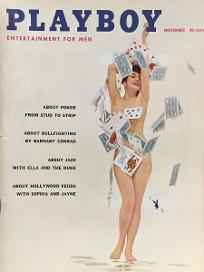
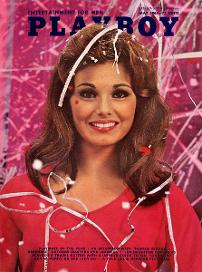
Marilyn Maher, Jane Hacklyn, Greta Thyssen, Gus Thorner, Linda Cristal, Collette Barrett, Nona Van Tosh, Chris James, Carol Lynley, Elga Anderson, Anita London, Leslie Caron. Jeanne Lane, Zsa Zsa Gabor, Sheila Jerome, Nona Candler and Denise Jones.
For camera equipment, Jerry preferred the Rolleiflex and Hasselblad for medium format and the Pentax and Leica M-3 for 35mm. For B&W film, he used Plus X, Pan X and Tri-X. For 35mm color transparencies, he liked Kodachrome and for medium format, Ektachrome.
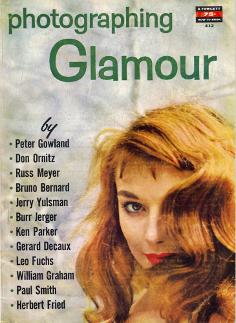
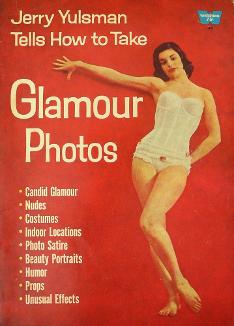
The Complete Book of 8mm Movie Making (1972)
The Complete Book of 35mm Photography (1976)
Color Photography Simplified (1978)
In the early 1980s, Yulsman began writing fiction and published two novels. Elleander Morning (1984) is an alternative history in which World War II never happened. The novel won several awards, including the 1986 Ditmar Award for best international fiction. The Last Liberator (1991) was based on Yulsman's WWII experiences as a tail gunner aboard a B-24 Liberator.
Jerry Yulsman died of lung cancer on Aug. 6, 1999 at Long Island College Hospital in Brooklyn, NY. He was 75 years old. At the time of his death, he was
working on Gotham, a novel celebrating New York. Yulsman's fourth wife, Barbara Woike, is an Associated Press editor and is remarried and living in Brooklyn. His son, Tom Yulsman, is a science and environmental journalist and co-director of the Center for Environmental Journalism at the University of Colorado, Boulder.
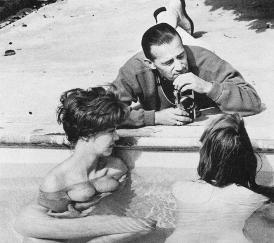
Gaby Martine and Marion Milford (1963)
Ken Parker - Kenneth Hensley Parker was born in Rockford, Illinois on July 27, 1909 and grew up in Terre Haute, Indiana. He served in the U.S. Army Signal Corps during WWII and shot images of some of the Nazi death camps after they had been liberated. After the war, Parker moved to California and became a Los Angeles Police Department photographer. According to Ken's daughter Paula, it was early in his 11 year term of service with the department that he photographed the gruesome Black Dahlia murder scene for police on January 15, 1947.
In the late 50s, Ken was dismissed from his job with the police department for moonlighting as a pinup photographer. It was secretly (at first) that he had entered the glamour field alongside his friend Russ Meyer (it was another of Meyer's war buddies, Don Ornitz, who advised Meyer to try glamour photography). Ken would sometimes photograph models along with Meyer and they would share the photo credit in magazines in which the images were published. For example, Ken Parker shot the B&W photos for Diane Webber's Feb. 1956 Playmate pictorial while Russ Meyer shot the centerfold.
Cameras used by Parker were a 35mm Nikon for B&W shots, using lenses from 35mm to 135mm. For color he used the Hasselblad medium format camera and its long lens - the 150mm for close-ups and portraits.
Some of the models photographed by Parker include: Diane Webber, June Wilkinson, Dawn Richard (June 1958 issue of Modern Man), Brigitte Baum, Doris Gohlke, Margo Gohlke, Dee Dee Candis, Karen Alden, Donna Long, Margie Moran, Laya Raki, Lauren Lavelle, Gaby Martine and Marion Milford.
On his cameras and photographic technique, Ken wrote in 1959: "When I started working with glamour and situation type photo layouts, the 35mm and its great mobility and ease of operation was just the answer as a camera choice, leaving the photog free to concentrate on the subject." He also wrote "Soft overcast daylight and open shade are perfect for outdoor glamour photography - the flesh tones are flattering and the model will be relaxed and comfortable."
Ken Parker's photos can be seen in the books "Photographing Glamour" (1959) and "Famous Photographers Photograph Beautiful Women" (1963) as well as in issues of various men's magazines from the 1950s and 60s. To see Parker in action (photographing the two models in the photo above), check out Russ Meyer's 1963 film "Heavenly Bodies".
Ken Parker passed away on Sept. 22, 1979 in Los Angeles, California. He was 70 years old.
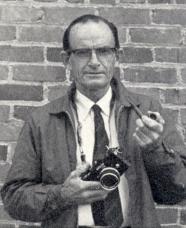
Harry Maxwell - Harry Maxwell was a glamour and figure photographer who had his work published in several magazines and books, including Modern Man, Figure Quarterly and Best Photography (1957).
Harry Maxwell's interest in photography began in the U.S. Army during WWII. Being stationed stateside, he became bored and started taking pictures as a hobby. "I had a preference for snapping shots around carnivals...catching people in action around ferris wheels, and so forth. It was a challenge to find the best possible moment to get an interesting shot. I also shot scenic pictures while stationed in Florida, Washington, D.C., Missouri, and the University of California, where I was a radar instructor". Living in Florida and California, with their overabundance of attractive young women, Maxwell's human interest photos of civilians eventually began to resemble cheesecake. By the end of the war, Maxwell was an expert photographer. However, his skill was not enough to convince him that he could succeed as a photographer.
Originally from Riverside, California, he had attended Chico High School and Chico State College in Northern California without any definite plans for a career. In postwar America, he was still undecided. While it was difficult to proceed with photography, it was impossible to turn back.
Maxwell initially opened a small studio in Los Angeles and started photographing weddings. Soon he branched into other areas of photography and began to hire a few models. Finally, he tried figure photography. "I found there was more interest in this field and sales began to justify my concentrating on figure work."
Researching figure photo markets and working with an agent, Maxwell soon had outlets for all his pictures. His first published photo of a pin-up girl in a bathing suit appeared in U.S. Camera and his first published nude appeared in Modern Man. By this time, he was working full-time as a glamour photographer.
While Maxwell maintained the he resisted being influenced by other photographers, he admired the work of Andre de Dienes, Peter Basch, Peter Gowland and Richard Avedon. "Avedon especially interested me because he is able to vary his style - which very few people can accomplish."
Camera equipment used by Mr. Maxwell included a Speed Graphic (modified so it would operate as rapidly as a Rolleiflex). "I use a roll back adapter on the Graphic for 2 1/4 x 3 1/4 or 2 1/4 inch square negatives." For certain situations, Maxwell also used a Rolleiflex, an Omega and a 35mm Contax.
Models photographed by Harry Maxwell included: Marilyn Wesley, Shirley Skates, Bunny Bacon, Mickey Jines, Pat Conley, Joan Webb, Cindy Taylor, Jean Nieto, Vicki Palmer, Glenda Graham, Nancy Lewis, Mona Miller, Kitty Roberts, Allison Sanborn, Barbara Devine, Sammy Lynne, Fifi La Monte, Angel Dubonnet, Barbara Graham, Fran Dair, Ann Peters, Carol Luis, Kathy Sharpe, Denise Daniels, Cindy Courtland, Hope Hathaway, Carol Bayne, Peggy Wheeler, Dana Craig, Aida Boyes, Donna Fisher, Kathy Ridgeway and Patti Brownell.
Maxwell's chosen profession had many rewards: "Seeing my work in Life and getting several letters from people at the magazine - complimentary and encouraging - has been a great reward."
When he was not working, Maxwell read about physics, astronomy, and psychology or spent his time enjoying the great outdoors. "I climbed every big mountain in California, including Mt. Whitney, Half Dome, and San Jacinto. I have an ambition to climb McKinley, but I may never make it."
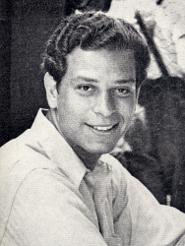
Irv Carsten - I first saw Irv Carsten's name in the Good Photography, Candid Photography and Salon Photography books (of which I am an avid collector). He submitted his glamour and nude photos to these books on a regular basis throughout the late 50s and the majority of the 1960s. One nude study that was published in Good Photography (1967) can be seen here.
Irving Carsten entered the photographic field shortly after he finished high school in The Bronx, N.Y.. He had decided to tour the country and purchased a second-hand Speed Graphic to record his travels on film. He shot pictures constantly and eventually became good enough to have a photo published in a section of a Sunday newspaper. In subsequent years, Carsten's photos began appearing in almost every national publication, including Life, Pageant, Coronet and Argosy.
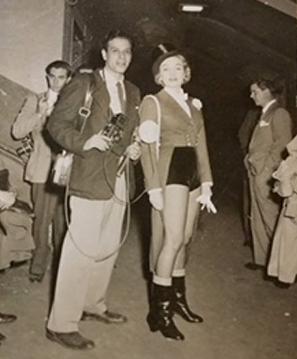
In the mid 50s, Carsten realized that he had a natural affinity for figure photography. His quick success in the field was instrumental in his decision to adopt figure and glamour photography as his specialty. "It is extremely gratifying," he said, "when a man gets paid for doing the sort of work he loves the most - the kind of work he might gladly do, otherwise, for free."
Some of the men's magazines that Mr. Carsten contributed to included Modern Man, Caper, Escapade, Beau and Sir Knight.
Models photographed by Irv Carsten include: June Palmer (Modern Man, March 1962), Lee Valentine, Cee Cee Collins, Sherri Nelson, Anne Walker, Susan Kaye, Mimi Harris, Myrna Goodside, Cynthia Dallice, Jeri Osaki, Marya Dmitriov, Alice Denham, Tina Maddison, Vangie John, Penny Rae, Joyce Palo, Anita London, Jayne Hacklin, Lily Christine, Betty Linden, Penny Martin, Anne Austin and Anita Martin.
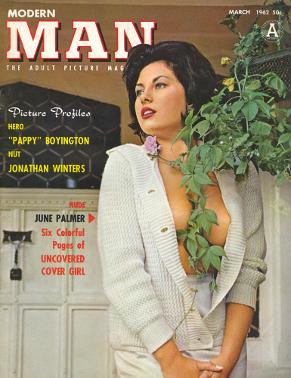
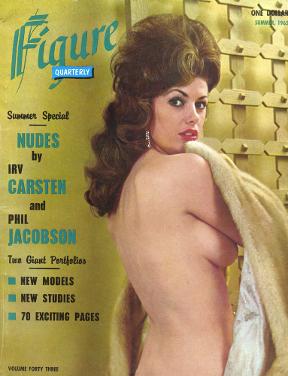
For shooting, Irv preferred to work "on location" and rarely used a studio setting. "New locations give me new inspiration", he said. "I love the freedom to come and go as I please."
On days when Carsten was not producing first-rate photographs, he turned to his other interests, which included guns, horseback riding, swimming and travel.
Update (June 16, 2017): Fellow photographer Paul Johnson wrote to let me know that Irv Carsten later moved to the San Francisco Bay Area and that he last saw him in a Union St. bar in the early to mid '80s. At that time, Irv worried that he was getting older and that he wouldn't be able to continue to shoot glamour and nudes much longer.
Update #2 (Feb. 4, 2018): Irv's daughter Diane wrote to tell me that Irv passed away on May 5, 2001 in West Palm Beach, Florida at the age of 81 (he was born on Nov. 7, 1919). After residing in San Francisco, Irv moved to San Miguel de Allende, Mexico and lived there for about 15 years until he became ill with cancer. He then moved to Florida, where he lived with his sister until his death. Irv Carsten had been married once and had three children - one daughter and two sons.
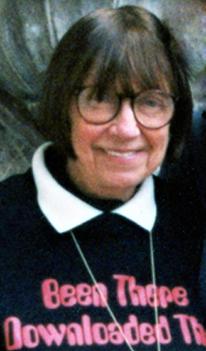
Dorothy Gunn - Dorothy Crowell Gunn was born in New York City on Oct. 28, 1917 to Andrew Ward Gunn and Fanny M. (Crowell) Gunn. On Nov. 12, 1922, Dorothy's mother gave birth to a second child, a son named Donald Ward Gunn. One month after giving birth, Fanny Gunn passed away. Dorothy was just 5 years old when her mother died. By 1930, at age 12, Dorothy was living with her maternal grandfather, Nelson B. Crowell, in Southampton, Massachusetts. As a youngster, Dorothy was a true "latchkey kid", as she wore a house key around her neck at school.
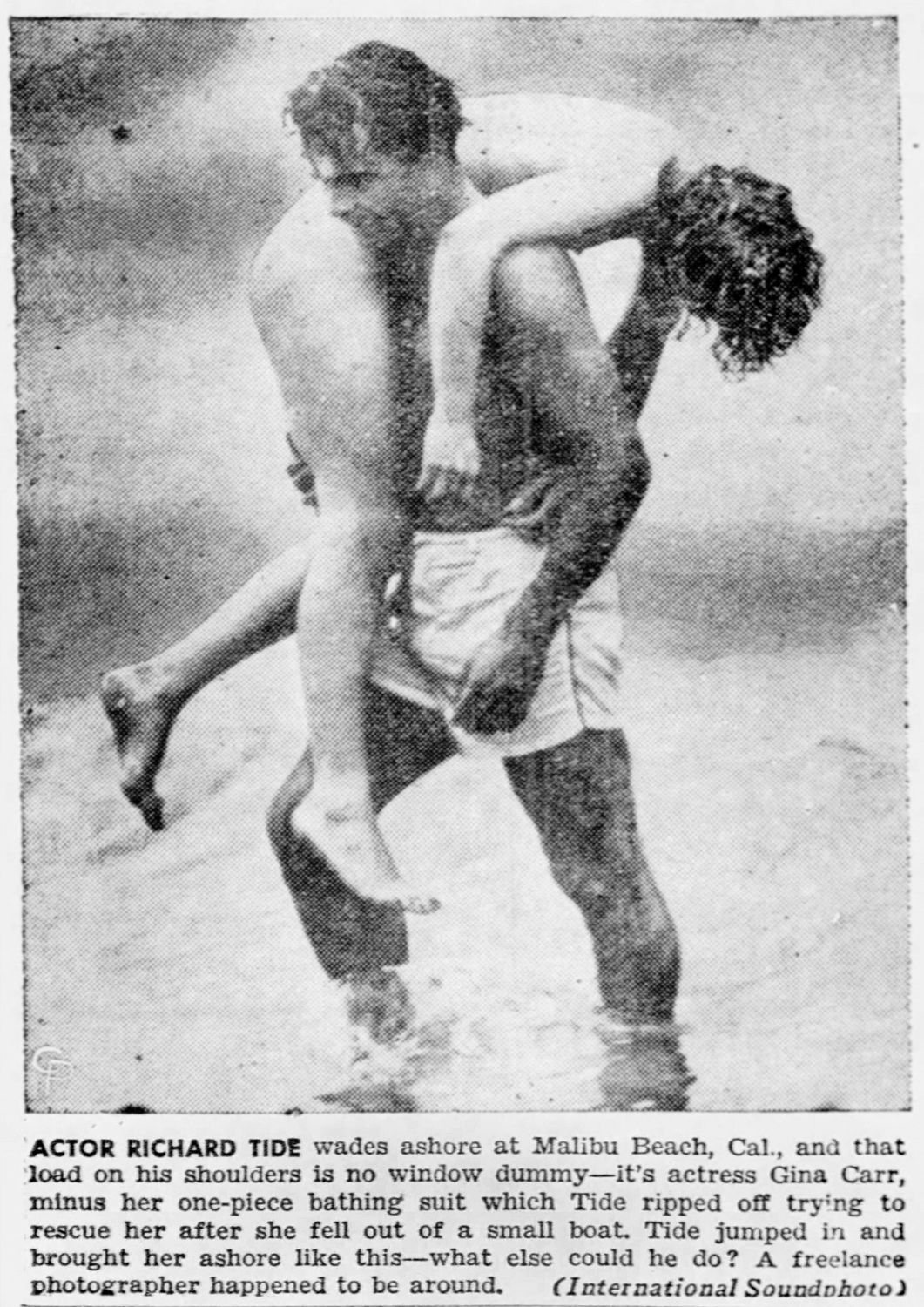
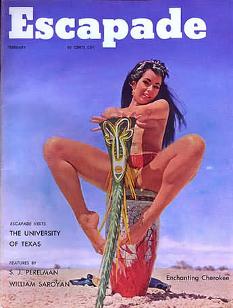
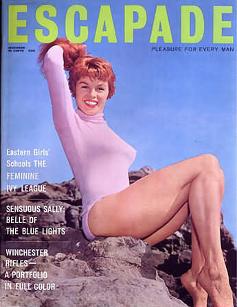
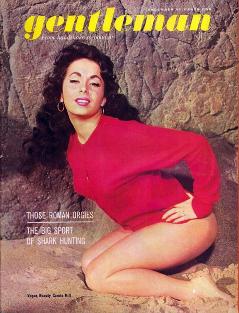

Celebrities and movie stars that Dorothy Gunn photographed included: Cary Grant, Elvis Presley, Harry Belafonte, Debra Paget (cover and photos inside the Sept. 1958 issue of Scamp magazine), Zsa Zsa Gabor (Fling magazine Vol. 1, No. 15 - 1959), Lisa Kirk, Anna Maria Alberghetti, Tuesday Weld and Ann Margret.
Working with the Vista photo agency, about half of Gunn's shooting was done in and around Las Vegas (where she had been doing publicity for the El Rancho Vegas hotel and casino since the early 50s), and the desert was one of her favorite shooting locations. The rest of her photos were usually taken at her L.A. home or at the beach.
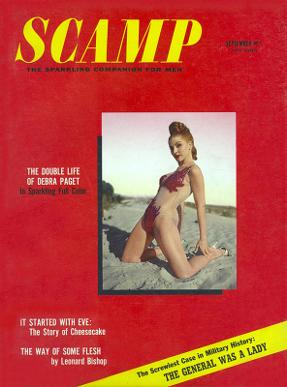
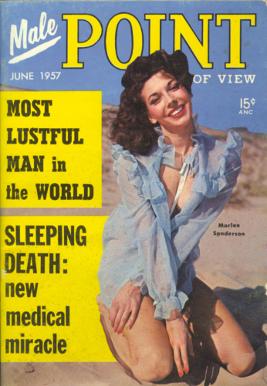
For camera equipment, Dorothy Gunn preferred to use three Rolleiflexes, two loaded with black and white and one with color. She almost bought a Hasselblad, but decided against it, because she also had to shoot in night clubs, where entertainers frown at the sharp sound of the focal plane shutter.
To get a good layout on a model, she shot a minimum of 100 black and white images, and if the model warranted it, three or four rolls of color film. For a really sensational model and certain magazine covers, she reverted back to her 4x5 Speed Graphic loaded with color film.
Some of Dorothy Gunn's excellent glamour photos can be seen in the books "The Technique of Figure Photography" (1959) and "Glamor Photos" (1962). Her photos also appeared in the 1960 edition of Salon Photography with an article entitled "Desert Glamour".
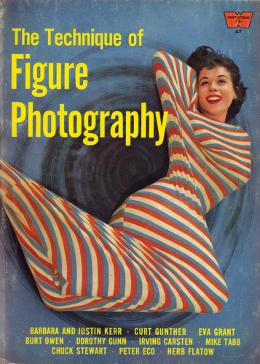
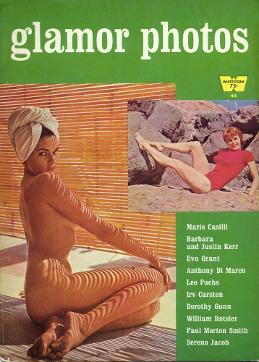
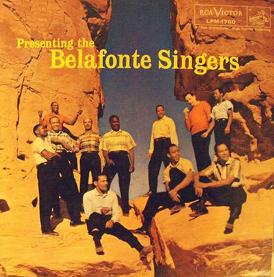
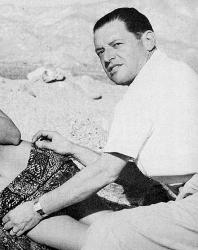
M. Richard Marx - M. Richard Marx's artistic nude images appeared in print in the early 50s to mid 60s in magazines such as Art Photography (1952), Figure Quarterly (Summer 1957 and Summer 1960) and Modern Man (in the Modern Art for Men section). A portfolio of his nude photographs was also published in the 1959 edition of Best Photography from Trend Books. Marx wrote at that time: "One of the greatest challenges and some of the best possibilities for creative work in photography are offered in the photography of the nude."
Born in Los Angeles on January 31, 1913, Marco Richard Marx spent his youth in that city and in San Francisco. He went east to attend the University of Pittsburgh, and after college, he returned to Los Angeles and worked in retail sales for a while.
Before going into the photography business for himself, Marx worked with Tom Kelley, well known west coast photographer, who, at that time was doing fashion and illustrative pictures for local and national advertisers. After a year with Kelley, Marx began freelancing and did advertising photography for companies like Eastman Kodak, DuPont and GAF. He continued to shoot a wide variety of subjects for years when he switched to nudes because he felt the need for experimentation and deviation from his daily routine. Marx also found that in working with nudes he became more adept when handling models for fashion work. For his nudes, Marx preferred a simple background such as a beach because he felt that it lent itself to a more relaxed and comfortable type of pose.
I do not have names of many of M. Richard Marx's models, as they were usually unidentified in order to keep his nude studies impersonal. However, one non-nude model that Mr. Marx photographed for Cover Girls Models magazine (June 1950) was Yvette Vedder (Yvette Vickers). Later, he shot a Modern Man layout of a model named Sharon Marlo (Modern Man Quarterly, Winter 1959).
Marx served in the army during WWII and in 1948, at age 35, married Beatrice Luce, who became his assistant during his photo shoots.
Aside from his nude work, Marx also contributed to such magazines as Sunset and House Beautiful, wrote a travel photography column for Westways magazine and wrote and illustrated two books, "About Mexico's Children" (1959) and "Printing with Variable Contrast Papers" (1961). He also had showings of his photos at several museums and galleries. In addition, Marx taught photography at East Los Angeles College for 14 years before retiring as professor emeritus.
M. Richard Marx passed away in Los Angeles, California on May 21, 1999. He was 86 years old.
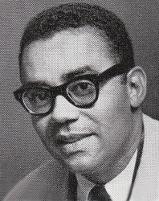
Wil Blanche - Born Wilbert H. Blanche on Dec. 13, 1916, Wil was a freelance photographer in New York who shot sports, jazz musicians and just about anything else he was inclined to shoot, including glamour. During the mid 50s to early 60s Wil Blanche achieved great success shooting glamour for publications such as Esquire, Modern Man, Caper and Scamp. By 1957, Wil's work was featured in the book "Beauty and the Camera", and two years later his photos appeared in the book "10 Top Glamour Photographers". Some of Blanche's glamour work was also published in the 1959 edition of Salon Photography in an article he wrote entitled "Ten Girls - One Negligee", which illustrated how he reused one costume for ten different models.
In addition to glamour, Blanche shot photos for many other publications, including Pageant, Look, Argosy and Ebony. In the 1950s, some of his photos did appear in Playboy magazine, but they were images of jazz musicians for the first Playboy Jazz Poll (Feb. 1957).
Actresses and glamour models photographed by Wil Blanche included: Eva Lynd, Betsy Manne, Virginia Lee, Enez Rome, Gloria Rhoads, Cyndee Maurice, Sandee Preston, Harriet Patterson, Jane Kean, Peggy Ray, Laya Raki (Sept. '59 issue of Scamp), Marion Moore, Jayne Mansfield (July '56 issue of Esquire), Madeline Petit, Julie Newmar, Polly Bergen, Colleen Miller (Oct. '56 issue of Esquire), Kitty Dolan (July '59 issue of Caper), Frances Beck, Doris Fesette, Jody Roth and Betsy Palmer.
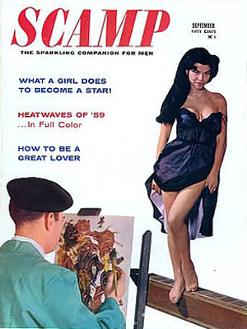
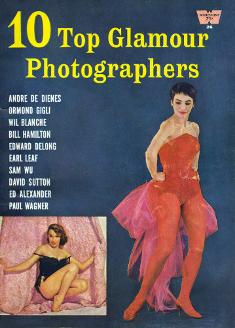
For his glamour photography, Wil used a combination of three film formats. The most frequently used was the 2 1/4 x 2 1/4 (Rolleiflex with f/2.8D Xenotar lens and Hasselblad with f/2.8 Ektar lens). The next format he used was the 35mm (Nikon with three Nikkor lenses - 35mm, 50mm and 105mm and a Miranda single lens reflex with a 180mm Sonnar lens). The other format, 4 x 5 (Super Linhof with 150mm and 240mm lenses), he used only for color transparencies in the glamour field, especially head and shoulder shots.
For shooting locations, Wil wrote: "Personally, I prefer doing glamour work in the great outdoors. Nature's backgrounds cannot be duplicated, but when frigid weather makes photographing girls in frilly feminine finery impractical, I go indoors. Sometimes the model's own home is used, or some swank apartment or house of friends and, of course, the photographic studio."
In the 1960s and 70s, Blanche shot a lot of sports, including soccer, tennis, basketball, baseball, football and boxing, some of which would be featured in Sports Illustrated. During the 60s he also continued to shoot covers for magazines such as Argosy. In the early 70s, Wil was hired to shoot around the NYC area by the newly formed Environmental Protection Agency. As part of the Documerica project, Blanche took pictures of landfills, water pollution and the rapidly changing Lower Manhattan skyline, including images of the newly completed Twin Towers of the World Trade Center.
In 1992, some of Wil Blanche's photos of New York City were used in the motion picture "The Public Eye" starring Joe Pesci as a Weegee-like photographer named Bernzy. Some of Bernzy's photos shown in the film were credited to Wil Blanche.
The next year, on May 5, 1993, Wil Blanche passed away in Thornwood, New York. He was 76 years old.
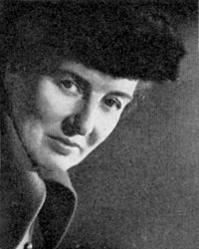
Joan Craven - Normally it is quite a challenging task to write a profile on a British photographer since I have no access, for example, to British birth and death records, but recently a relative of Joan's, Shona Craven, decided to do some research on her great aunt. I will use some of Shona's information, along with facts that I can glean from American periodicals that published her nude photographs, to fill out the profile.
I first saw some of Joan Craven's photos in Figure Annual Volume 7 (from 1956) that I had purchased from ebay (looking for bios of the various photographers that I wanted to profile). There was little biographical info on Joan in that magazine, so I had almost given up writing anything about her, until now. Joan Craven certainly broke the mold of the stereotypical figure photographer, as she was an older woman who shot nudes. By the early 1950s, when she seemingly started doing figure studies almost full time, she was 53 or 54 years old.
Joan Craven was born Mabel Craven in Leeds in 1897, the daughter of Marshall and Lucy Craven. According to Figure Quarterly (Fall 1957): Miss Joan Craven is the society-bred fine-featured descendant of a long line of Yorkshire Cravens. She is a small, delicate woman with a defiant will and an iron desire to remain a rugged individualist. On Bond Street she rubbed elbows with famous stage personalities during her youth, as well as prominent members of the nobility and gentry. "How I used to loathe those dreary court affairs," she recalled. "They started in the evening and went on into the next morning, with the debutantes and their relatives, the ridiculous feathers on their heads, court trains sweeping the marble floors." After she had her fill of this, Miss Craven decided to make a career of her favorite hobby and opened her own studio on Bond Street in the early 1920s. Her work included photographs of ballerinas including Lydia Sokolova and Alexandra Danilova, and early portrait subjects included the French actress and pianist Yvonne Arnaud and British pianist Harriet Cohen.
By the mid 20s, Joan had already started to experiment with figure photography and one of her photographs that was published in 1926 was a nude version of Pandora, from Greek mythology. However, Joan continued her portrait, fashion and advertising work for the next few decades (when at some point in time, she moved into a studio in Kinocrat House on London's Cromwell Road).
"But," she confided in 1957, "I couldn't bear having the studio full of longhaired advertising layabouts and fat bald-headed entrepreneurs all with different ideas, all telling me what to do. I am a patient woman, but one day, driven desperate by all this nagging, I yelled 'Oh, take the picture yourself,' and walked out." It was following this incident that the sensitive blue-blood turned to figure photography in the late 1940s. She found working with a young beautiful model a form of relaxation rather than a commissioned task. "I could please myself entirely," said Miss Craven, "and if I also pleased the judges in the exhibitions, well that was highly satisfactory if not very remunerative."
It was a few years later, in 1952, when Joan's photographs began appearing in American periodicals such as Art Photography, Figure Quarterly, Figure Annual and later, the men's magazine Modern Man (in the Modern Art for Men section that featured figure photography from some of the leading glamour photographers of the day). One of Miss Craven's models was the popular English nude model Pamela Green.
Of her technique with lighting, Joan wrote in 1956: "I have my personal working method, which is largely subconscious, and I imagine, almost instinctive. I visualize the completed picture in my mind's eye first and then move my lights until I obtain the effect I am after." She continued: "Personally, I am fond of high key work, especially when I find a slim, lovely, fair-skinned model which this type of picture requires. My general lighting set-up for this type of work is to use two floodlights as my frontal lights, one as a main source and the other as a fill. For accent lights, I add two spots on both sides of the model to pick up highlights on the hair and accentuate a curve of the cheek or breast."
By 1957, according to Figure Quarterly: "Her nudes, all classically expressive and full-bodied creatures, have long since made her financially independent. She works sporadically now, allowing plenty of time to 'just stand and stare at the natural treasures of life'."
On the more personal side, Joan Craven was married twice, the first time in 1933 to John Shorland. Joan later lived for a spell in the 1950s in an 18th-century house called Heath Lodge in Redbourne, Hertfordshire before marrying Lieutenant Commander Geoffrey Lewis and moving to Plymouth. Joan Lewis died on July 2, 1979 at her home in the village of Tamerton Foliot in Plymouth.
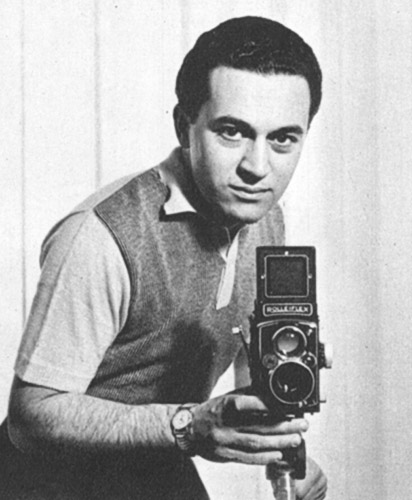
Anthony DiMarco - Anthony C. DiMarco entered the photographic field around 1947 and by 1952, he finally made his hobby of photography pay off. He specialized in portraits, pinups and figure studies, but it was the latter two categories that appeared in men's magazines of the 1950s and 60s. Specifically, his figure photography appeared most often in the Modern Art for Men section of the magazine Modern Man. This feature became a regular fixture in the magazine sometime in mid 1957.
Concerning his endeavors in the glamour field, he confided: "Finding models is a problem, even in a town such as Hollywood where there are probably more beautiful girls than anywhere else in the world." He realized that the best models were those who posed because they knew that the publicity would do them some good.
Some of Anthony DiMarco's models included: Sandra Smith, Carol McBee, Angela Blake, Bambi Day, Sonia West, Alice Adams, Barbara Parkins, Miche Swanson, Roni Scott, Amiza Roda, Vi Palmer, Doris Gohlke, Margie Moran, Anne Fleming, Tara Thomas, Elaine Summers, Barbara Thomason (Modern Man Quarterly Winter Edition 1959), Alyce Keller, Diane Collier, Joanne Forsythe, Vivian Maledy, Virginia DeLee, Rusty Fisher and Ann Peters.
For film equipment, DiMarco used a Rolleiflex about 90 percent of the time for everything except portraits, for which he used a 4x5 view camera. He did all of his own darkroom work except for retouching of his portraits.
DiMarco liked outdoor photography better than studio work because of the advantages of natural lighting and backgrounds. In the studio, he preferred the use of very simple props such as a fish net, a swing, or a chair and just left it to the imagination of his models to come up with completely original poses.
The nude photography of Playboy and other men's magazines was the trend at the time Anthony DiMarco began to become successful, yet he hoped that it would change back to the all-American-type-of-girl photography that was in vogue when he first started in the photographic field in the late 40s. He felt that it was much easier to get models for that type of photography.
Although Anthony DiMarco's work didn't appear in Playboy during the 1950s, one of his studio photos of Rusty Fisher (Miss April 1956) posing nude on a swing did appear in the Playboy special edition "Playboy's Playmates: The First 15 Years", which was published in 1983.
A portfolio of Anthony DiMarco's glamour photography also appeared in the 1957 edition of Best Photography along with those of other photographers of the era such as Peter Gowland, Andre de Dienes and David M. Mills.
Update (July 20, 2020): Anthony Charles DiMarco was born on January 18, 1928 in Los Angeles, CA. His parents were Charles and Mae DiMarco. Sometime in the late 50s or early 60s, Anthony was using the address of the Los Angeles home he grew up in as his business/studio address, and today, at age 92, he still owns and lives in the same home. Over the past few years, I've sent a couple of letters to Anthony DiMarco seeking more information on his life and career, but the letters always went unanswered.
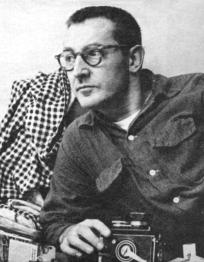
Edward Lettau - Edward Charles Lettau, born on Aug. 2, 1920 in Rochester, NY, was a highly successful East Coast photographer who shot for numerous magazines in the 1950s, among them some glamour oriented magazines of the mid 50s (Art Photography, Glamour Photography, Charm Photography, Creative Photography, Classic Photography, Master Photography, etc.).
Ed Lettau did not begin to shoot pictures until a comparatively late age, but once bitten by the photographic bug he worked hard to make up for lost time. Until he went into the army at twenty, he wanted to be an artist and took courses with that goal in mind. After a year in the service, Ed married Ruth Toporcer. He left the army in 1946 with a burning desire to become a photographer, but it was a full year before he could get into New York's School of Modern Photography. After completing the course Lettau wasn't quite sure what he wanted to do since he knew that magazine photography was in an overcrowded condition. By this time, he had moved his wife, two baby girls and himself to a Quonset hut housing project near Jamaica Bay, Long Island.
Early in 1949, the Lettaus moved to Scarsdale, NY and a house with a spare room under the front porch, which Ed converted into a darkroom. In this house Ed built up a brisk home portrait business largely through word of mouth advertising. Ed's portrait business was a spare-time project in addition to a regular job as a laboratory technician for a studio specializing in wedding pictures.
The next turn in the road came for Lettau when he read an article about a successful young photographer named Peter Basch. Ed landed a job with him as an assistant, a position that allowed him to broaden his experience in taking pictures. Less than a year later he learned of a job in Bedford Hills, quite close to Scarsdale and decided to make the move. In the Philip Litchfield Studio, Lettau began to find himself photographically. His growth was made possible by Litchfield's cooperation in allowing Ed to use the studio for personal work and giving him a free hand in carrying out studio assignments.
Beginning in 1953, Lettau began devoting almost all his time to doing magazine picture stories on a freelance basis. He was then definitely sure that he wanted to do nothing else. With the mid 50s being the heyday of glamour photography, Ed shot quite a few glamour stories. For the August 1955 issue of Pageant magazine, Ed photographed a 6 page pictorial of model Jayne Hacklin entitled "The Girl Who Has Almost Everything". For the June 1956 issue of Art Photography, he wrote an article entitled "Glamour...You Have To Work At It" accompanied by several of his glamour photos. Also in 1956, he had five of his photos published in Charm Photography (No. 3). In 1957, Lettau penned an 8 page article for Good Photography entitled "Glamour Outdoors" which was illustrated with 11 of his photos. That same year, he authored a 6 page article for Salon Photography which featured his "Outdoor Portraits" of women. In the August 1958 issue of Pageant, he shot the photos for the article "The Non-Swimmers League", which showcased several swimsuit-clad glamour models. Edward Lettau's glamour photography would also appear in publications such as Classic Photography and Master Photography as well as the photo digests Candid Photography and Prize Winning Photography. One of my favorites was this image, which appeared in the 1956 edition of Candid Photography.

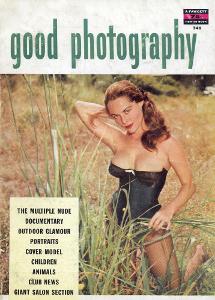
Using his favorite camera, the Rolleiflex, Lettau did much of his shooting in available light - which quite often is weak, sometimes too weak to normally develop film. In instances like that he used Dektol, a paper developer, for film. It does produce grain but he felt there are elements in a picture that are of greater importance than grain. He actually liked an occasionally grainy picture to set a mood. Under normal conditions, he developed his film, Super XX, in Microdol. By developing Tri-X in DK50 or Dektol, he was able to get a picture under the most extreme lighting conditions.
A firm believer in keeping equipment down to a bare minimum, he went on a typical indoor glamour shoot carrying only a Rolleiflex, two light stands, a tripod, three #2 photofloods, an extension cord, a meter, cable release and sufficient film. For outdoor assignments, he took the Rollei, tripod, meter, cable release and film. Anything else would slow down the shooting and he wouldn't be able to get the variety he wanted.
A few of Lettau's glamour models included: Barbara Bostock, Beverly Anderson, Donna Dettaan, Jayne Hacklin and Betty Ann Mohrmon.
The versatile ease with which he handled a wide range of subjects stemmed partly from his search to find himself photographically, and partly from the intense enthusiasm he held for all camera work. His nudes, still-life's, glamour work, child portraits and animal pictures, combined a quiet, almost classic simplicity with an imaginative kick that made them unforgettable.
Photography would basically become Lettau's hobby as well as his business. As he stated it: "It's really quite pleasing not to be under pressure and to be able to do exactly what you want."
In his later years, Lettau did quite a lot of stock photography, with some of those photos being used to this day to accompany various articles in magazines and on the internet. One of his photos of a malnourished little girl made the cover of Newsweek magazine for Nov. 11, 1974 (for a story on world hunger).
